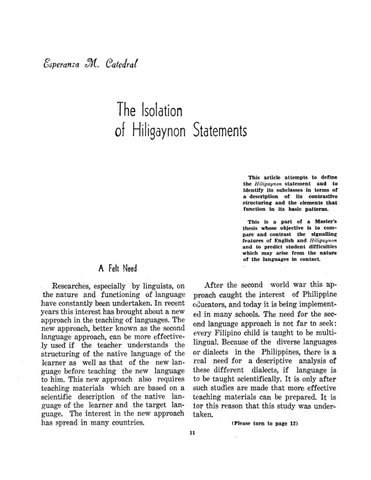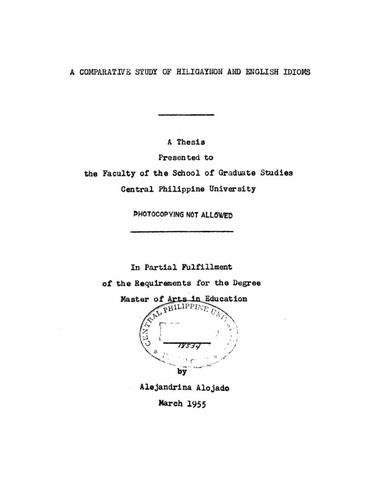Ipakita ang simpleng tala ng item
The isolation of Hiligaynon statements
| dc.contributor.author | Catedral, Esperanza M. | |
| dc.date.accessioned | 2022-06-13T04:44:43Z | |
| dc.date.available | 2022-06-13T04:44:43Z | |
| dc.date.issued | 1965-01 | |
| dc.identifier.citation | Catedral, E. M. (1965). The isolation of Hiligaynon statements. The Teachers Journal, 2(2), 11-29. | en_US |
| dc.identifier.uri | https://hdl.handle.net/20.500.12852/2091 | |
| dc.description | Journal article | en_US |
| dc.description.abstract | This article attempts to define the Hiligaynon statement and to identify its subclasses in terms of a description of its contrastive structuring and the elements that function in its basic patterns. This is a part of a Master’s thesis whose objective is to compare and contrast the signaling features of English and Hiligaynon and to predict student difficulties which may arise from the nature of the languages in contact Researches, especially by linguists, on the nature and functioning of language have constantly been undertaken. In recent years this interest has brought about a new approach in the teaching of languages. The new approach, better known as the second language approach, can be more effectively used if the teacher understands the structuring of the native language of the learner as well as that of the new language before teaching the new language to him. This new approach also requires teaching materials which are based on a scientific description of the native language of the learner and the target language. The interest in the new approach has spread in many countries. | en_US |
| dc.language.iso | en | en_US |
| dc.publisher | Central Philippine University | en_US |
| dc.subject.lcsh | English language--Study and teaching--Foreign speakers | en_US |
| dc.subject.lcsh | Second language acquisition | en_US |
| dc.subject.lcsh | Hiligaynon language | en_US |
| dc.subject.lcsh | Hiligaynon language--Grammar | en_US |
| dc.subject.lcsh | Grammar, Comparative and general | en_US |
| dc.subject.lcsh | English language--Grammar, Comparative | en_US |
| dc.subject.lcsh | Hiligaynon language--Grammar, Comparative | en_US |
| dc.subject.lcsh | Phraseology | en_US |
| dc.subject.lcsh | Terms and phrases | en_US |
| dc.subject.lcsh | English language--Sentences | en_US |
| dc.subject.lcsh | Hiligaynon language--Sentences | en_US |
| dc.title | The isolation of Hiligaynon statements | en_US |
| dc.type | Article | en_US |
| dcterms.accessRights | Publicly accessible | en_US |
| dc.citation.firstpage | 11 | en_US |
| dc.citation.lastpage | 29 | en_US |
| dc.citation.journaltitle | The Teachers Journal | en_US |
| dc.citation.volume | 2 | en_US |
| dc.citation.issue | 2 | en_US |
Mga file sa item na ito
Lumilitaw ang item na ito sa mga sumusunod na (mga) Koleksyon
-
The Teachers Journal [9]
The Teachers Journal is the first journal published by Central Philippine University in 1964





